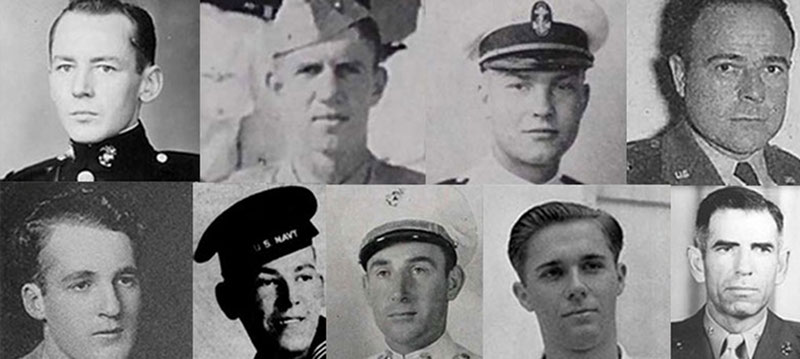
By Bert Ho, Senior Underwater Archaeologist - National Park Service
April 27 – May 19, 2017

Some of the servicemen involved in the near shore crashes. Top row (L to R): Russell B. Aitken, Timothy Casady, and Ray Leland Obenshain Jr.; Middle row (L to R): Charles W. Somers, Richard G. Newhall, and Daniel L. Cummings; Bottom row (L to R): Harold G. Schlendering, Eystein J. Nelson, and Edward Wieczorek. Image courtesy of Exploring the Sunken Heritage of Midway Atoll expedition. Download image (jpg, 58 KB).
After we returned to Honolulu, we took a couple of days to decompress and download our data and share our experiences with Kelly at the Monument headquarters on Ford Island.
If you have ever been to Pearl Harbor, you know that the military is all around you, and there are still many visual reminders of what happened on December 7, 1941. The overturned hull of the USS Utah is within view from Kelly’s office, the USS Arizona Memorial can be seen from the bridge to Ford Island, and the strafing marks on the launch ramp for the float planes are still visible.
Midway Atoll is no different, the landscape of the island was, and still is, largely defined by what the military built and left behind, both on land and in the water. The original seaplane launch, complete with anchor points for the planes dotting the concrete slabs; an original airplane hangar with bullet holes visible in the metal walls; and the original generator building where a Japanese shell launched from a passing ship on the evening of December 7, 1941, killed LT. George Cannon, U.S. Marine Corps, who was the first Marine in World War II to be awarded the Medal of Honor. These are all monuments to the past, and reminders of the events that took place 75 years ago on two tiny islands in the north Pacific.
Our project was sub-titled “Honoring the Legacy of the 75th Anniversary of the Battle of Midway” purposely because we feel that this project—this survey and documentation of planes—is the best way for us to honor those who fought and lost their lives in the Battle of Midway. As archeologists and historians, we strive to tell the whole history accurately, with as many tangible artifacts as we can find to guide us to that goal. We also need to show the public what we find in a meaningful way, that corroborates the history we are telling, and hopefully in a way that enriches their knowledge of the past with visuals from the present.
At the 2017 Society for Historical Archaeology Conference this past January in Fort Worth, Texas, I gave a talk about this project to search for lost aircraft from the Battle of Midway. I spoke of the survey plans, the historical research being gathered, and the photogrammetry objective to document known wreck sites. I also stressed that the true goal of the project was to discover the individual stories of the young pilots that had the courage to fight despite the great odds stacked against them. Their stories need to be told, and it is our responsibility to tell them truthfully to as large of an audience as possible.
For this project, NOAA’s Office of Ocean Exploration and Research (OER) has provided a great audience and we are very grateful for the many OER staff updating the website and sharing the mission logs. We feel that the data and findings from this project have expanded our knowledge of what may be left behind from the Battle, but also it has expanded our knowledge of the maritime history of Midway beyond the 20th century.
Like most research projects, the data gathered and discoveries made have led to many more questions, and of course, more work to do. It will take some time to analyze the possible engine finding before making any conclusions as to whether it is American or Japanese, from the Battle of Midway or later, and what aircraft it is from. This is all work we are eager to do, and when we are done, we know there will be an amazing story to tell.